Ogcocephalidae
Batfishes
Theodore W. Pietsch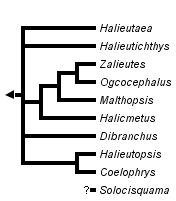


This tree diagram shows the relationships between several groups of organisms.
The root of the current tree connects the organisms featured in this tree to their containing group and the rest of the Tree of Life. The basal branching point in the tree represents the ancestor of the other groups in the tree. This ancestor diversified over time into several descendent subgroups, which are represented as internal nodes and terminal taxa to the right.

You can click on the root to travel down the Tree of Life all the way to the root of all Life, and you can click on the names of descendent subgroups to travel up the Tree of Life all the way to individual species.
For more information on ToL tree formatting, please see Interpreting the Tree or Classification. To learn more about phylogenetic trees, please visit our Phylogenetic Biology pages.
close boxIntroduction
The batfishes are a family of lophiiform fishes that includes 68 species distributed among 10 genera. These fishes are marine bottom-dwellers that feed on small invertebrates and fishes. The esca appears to exude a fluid that may function as a chemical lure; however, the chemical properties of this substance remain unknown. Although batfishes are taken regularly in commercial fishing operations, they are rarely eaten and do not support a fishery.
Characteristics
Diagnosis
Small to medium-sized lophiiform fishes (to 25 cm), dorsolaterally compressed (except for species of Coelophrys). Head large, triangular or circular in outline, forming a disc. Esca within cavity just above mouth, in most species a smooth-skinned glandular structure that can be extended in front of the mouth a short distance; dorsal margin of cavity a protective rostrum formed of close-set tubercles. Eyes of moderate size, about 7 to 15% of standard length; skin surrounding the iris often covered with prickle-like scales, visible in dorsal view but directed anterodorsally. Mouth small, overhung by rostrum in some species; lips usually thickened; jaw teeth minute, arranged in rows on pads. Palatines and vomer with or without teeth. Gill openings small, round, located behind the pectoral fin attachments, directed dorsally. Branchiostegals 6. Dorsal fin small, only 4 to 7 short rays (sometimes absent), located on tail halfway between disc and caudal fin. Anal fin slender, lappet-like, only 3 or 4 rays. Pectoral fins attached to sides of disc, appearing leg-like. Pelvic fins attached to ventral surface of disc anterior to pectoral fins, with 1 spine and 5 soft rays. Lateral-line organs a series of free neuromasts appearing as fleshy knobs, most prominent on ventral margins of disc and lateral sides of tail. Scales highly modified to form conical tubercles, variable in size from minute prickles to large strong spiny structures. Short hair-like extension of skin (cirri) often present, especially around edges of disc and sides of tail.
Color variable, fresh specimens often pink to reddish; dark markings may be present on dorsal surface of disc in the form of reticula, rings, or blotches.
Discussion of Phylogenetic Relationships
The hypothesized relationships of the Ogcocephalidae as presented by Endo and Shinohara (1999). Numbers on the cladogram represent transformation series as "character number (primitive-derived)." Character reversals are indicated by an asterisk. For character states, click here: 1, 2, 3, 4, 5, 6, 7, 8, and 9.
The interrelationships of ogcocephalid genera were analyzed by Endo and Shinohara (1999) based on characters discussed by Bradbury (1967). Endo and Shinohara (1999) reported a sister relationship between Coelophrys and Halieutopsis supported by the following synapomorphies: normal frontal bones, spine-like illicial bone, and pectoral fins not forming an elbow. They also reported that Coelophrys and Halieutopsis form a larger clade with Dibranchus, Halicmetus, Malthopsis, Zalieutes, and Ogcocephalus supported by the following synapomorphies: an interrupted lateral line on tail and holobranchs present on second and third gill arches, absent on fourth gill arch. The genus Solocisquama Bradbury (1999) was not included in the Endo and Shinohara (1999) analysis because it had not yet been described.
The following are the transformation series used in the cladistic analysis of the ogcocephalid genera by Endo and Shinohara (1999):
- Lateral line on ventral surface of tail absent (0), present and uninterrupted (1), present and interrupted (2);
- large conical scales (“bucklers”) absent (0), present (1);
- papillary operculum of iris absent (0), present (1);
- teeth present on jaws and palatines present (0), absent on palatines (1), absent or reduced on jaws, palatine, and tongue (2);
- frontal bones normal (0); forming a groove (1), forming a tube (2);
- holobranchs present on second and third gill arches, hemibranchs present on fourth gill arch (0); holobranchs present on second and third gill arches; fourth gill arch without gill filaments (1);
- esca ovular (0), triangular (1), trilobed (2);
- shape of illicial bone unmodified (0), spine-like (1);
- pectoral fins without elbow (0), with elbow.
Key to the Known Genera of the Family Ogcocephalidae

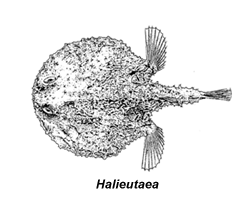

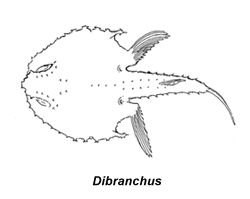

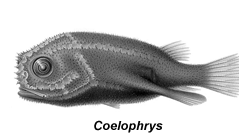

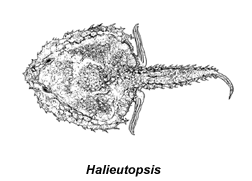

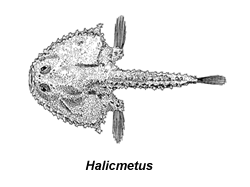


1A. Deep notch or cleft on anterior midline of upper jaw (= Solocisquama, four species, Indo-Pacific Ocean)
1B. No notch in upper jaw (go to 2)
2A. Pads of teeth on vomer and palatines (go to 6)
2B. No teeth on palatines (go to 3)
3A. Gills 2 ½ (holobranchs present on second and third gill arches; hemibranchs present on fourth gill arch) (= Halieutaea)
3B. Gills 2 (holobranchs present on second and third gill arches; fourth gill arch without gill filaments) (go to 4)
4A. A large pad of teeth on each fifth ceratobranchial, the two pads meeting along midline of floor of mouth to form a broad, toothed, tongue-like structure (=Dibranchus, thirteen species, Atlantic and Pacific oceans)
4B. No teeth on fifth ceratobranchials, or small pads of teeth present on floor of mouth, each surrounded by epithelium, not meeting along midline (go to 5)
5A. Body box-shaped, not strongly dorsoventrally flattened; pelvic fins reduced; illicial cavity large and cavernous; pelvic fins minute, barely emerging from ventral surface of body (= Coelophrys, including Halieutopsis micropa, five species, Indo-Pacific Ocean)
5B. Body strongly dorsoventrally flattened; pelvic fins not reduced; illicial cavity small, nearly fully occupied by esca; pelvic fins well developed (= Halieutopsis, except for H. micropa, ten species, Indo-Pacific Ocean)
6A. Face upturned, esca and mouth visible in dorsal view; dorsal fin often absent (= Halicmetus, two species, Indo-Pacific Ocean)
6B. Face not upturned, rostrum overhanging esca and mouth (go to 7)
7A. Underside of body naked; pectoral-fin lobe attached to tail by skin; esca within illicial cavity often obscured by puffy skin (= Halieutichthys, two species, Western Atlantic Ocean)
7B. Underside of body completely covered with small prickle-like scales and/or conical tubercles; pectoral-fin lobes separated from tail, forming distinct “elbows”; esca conspicuous within illicial cavity (go to 8)
8A. Underside of tail densely covered with small prickle-like scales; a few larger conical tubercles sometimes present, especially along midline; species generally large, attaining a maximum standard length of more than 80 mm (= Ogcocephalus, twelve species, Western Atlantic and Eastern Pacific oceans)
8B. Underside of tail densely covered with small prickle-like scales as above, but also a longitudinal row of larger conical tubercles on either side of ventral midline; small species, usually 80 mm standard length or less (go to 9)
9A. Rostrum short, cone-shaped, directed anteriorly, with an equally sized conical tubercle flaring out on each side; subopercular spine poorly developed (= Zalieutes, two species, Western Atlantic and Eastern Pacific oceans)
9B. Rostrum short, slender, markedly upturned, without a prominent conical tubercle on each side; subopercular spine large, thick, directed posteriorly (= Malthopsis, six species, Western Atlantic and Indo-Pacific oceans)
References
Bradbury, M. G. 1967. The genera of batfishes (Ogcocephalidae). Copeia, 1967: 339-422.
Bradbury, M. G. 1988. Rare fishes of the deep-sea genus Halieutopsis: a review with descriptions of four new species (Lophiiformes: Ogcocephalidae). Fieldiana Zool., 44: 1-22.
Bradbury, M. G. 1999. A review of the genus Dibranchus with descriptions of new species and a new genus Solocisquama, (Lophiiformes; Ogcocephalidae). Proc. Calif. Acad. Sci., 15(5): 259-310.
Endo, E., and G. Shinohara. 1999. A new batfish, Coelophrys bradburyae (Lophiiformes: Ogcocephalidae) from Japan, with comments on the evolutionary relationships of the genus. Ichthyol. Res., 46(4): 359-365.
About This Page
Theodore W. Pietsch

University of Washington, Seattle, Washington, USA
Correspondence regarding this page should be directed to Theodore W. Pietsch at and Christopher P. Kenaley at
Page copyright © 2005 Theodore W. Pietsch
 Page: Tree of Life
Ogcocephalidae. Batfishes.
Authored by
Theodore W. Pietsch.
The TEXT of this page is licensed under the
Creative Commons Attribution-NonCommercial License - Version 3.0. Note that images and other media
featured on this page are each governed by their own license, and they may or may not be available
for reuse. Click on an image or a media link to access the media data window, which provides the
relevant licensing information. For the general terms and conditions of ToL material reuse and
redistribution, please see the Tree of Life Copyright
Policies.
Page: Tree of Life
Ogcocephalidae. Batfishes.
Authored by
Theodore W. Pietsch.
The TEXT of this page is licensed under the
Creative Commons Attribution-NonCommercial License - Version 3.0. Note that images and other media
featured on this page are each governed by their own license, and they may or may not be available
for reuse. Click on an image or a media link to access the media data window, which provides the
relevant licensing information. For the general terms and conditions of ToL material reuse and
redistribution, please see the Tree of Life Copyright
Policies.
- First online 31 October 2005
Citing this page:
Pietsch, Theodore W. 2005. Ogcocephalidae. Batfishes. Version 31 October 2005 (under construction). http://tolweb.org/Ogcocephalidae/22028/2005.10.31 in The Tree of Life Web Project, http://tolweb.org/




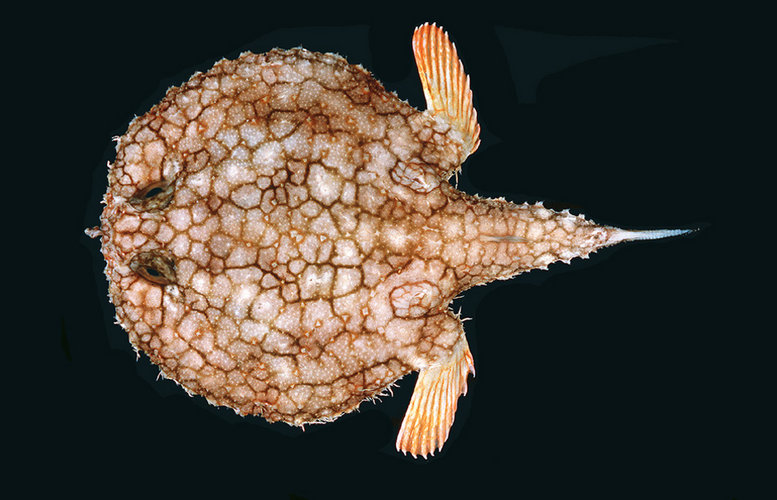
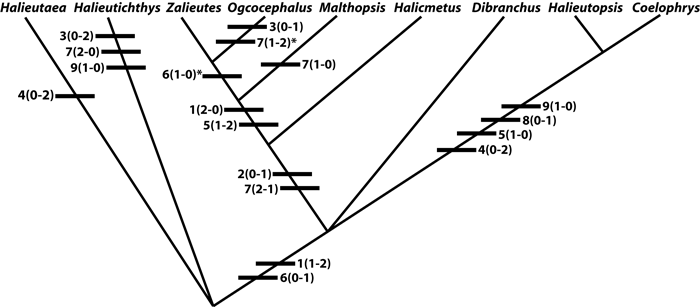



 Go to quick links
Go to quick search
Go to navigation for this section of the ToL site
Go to detailed links for the ToL site
Go to quick links
Go to quick search
Go to navigation for this section of the ToL site
Go to detailed links for the ToL site